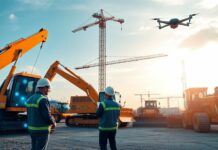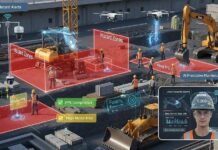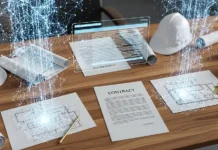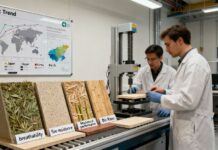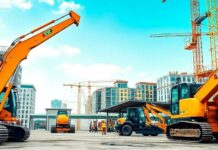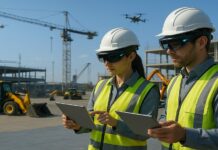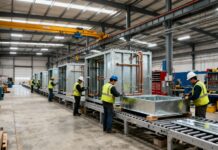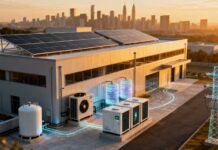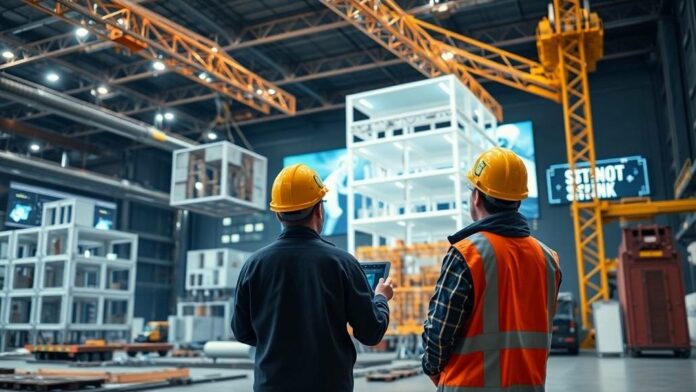The convergence of artificial intelligence (AI) and construction processes such as Design for Manufacturing and Assembly (DfMA) is a paradigm shift in designing, manufacturing, and assembling buildings. As off-site construction is accelerating, AI-driven DfMA is proving to be a game-changing tool for maximizing efficiency, reducing costs, and increasing sustainability.
Offsite construction is not new, but the need to address issues such as labor shortages, inefficiencies in projects, and the need for sustainability has made offsite construction increasingly relevant. The construction industry is transforming with the use of AI so that the DfMA processes (Design for Manufacturing and Assembly) can result in a new level of productivity and innovation.
The Basics of DfMA in Construction
Design for Manufacturing and Assembly (DfMA) is a methodology that has a focus on manufacturability and ease of assembly during the design process. DfMA was originally part of manufacturing but is becoming more important for construction by allowing components to be prefabricated off-site and assembled on-site rapidly.
DfMA offers two significant benefits to construction:
- Manufacturing: Building components are manufactured under factory-controlled conditions with standardization, favoring consistency and minimizing waste.
- Assembly: The modular components are made to be easily assembled on site, shortening overall project duration and limiting exposure to external elements.
Designers in conventional DfMA methods apply known guidelines and seasoned judgment. Conventional methods, however, lack the capability to incorporate large datasets or foretell outcomes accurately, making them restrictive. AI technology fills those voids by improving data-driven decision-making and automating key processes.
AI Applications in DfMA Processes
- Optimized Design: AI computational procedures scrutinize intricate variables including structural integrity, efficiency in energy consumption, and utilization of materials to produce optimal designs. This implies that DfMA components are not only functional but also very efficient and economical.
- Automated Manufacturing: AI software easily blends with automated equipment within manufacturing plants. For example, robotic arms that have AI installed can modify their movements in real time to produce accurate components. This lowers error rates and results in better-quality outputs.
- Supply Chain Optimization: AI refines supply chain management by anticipating material demand, planning for delivery in advance, and cutting delays. This is especially important in off-site construction, where coordination between manufacturing and assembly has to be seamless.
- Construction Assembly Simulation: Prior to the assembly of a single piece on-site, AI-based simulation platforms simulate the assembly process in virtual worlds. This brings out potential bottlenecks and guarantees that the on-site process is smooth.
- Predictive Maintenance: AI processes wear and tear information from factory equipment to foretell maintenance when it needs to be done, minimizing downtime and ensuring productivity at the highest levels.
The Impact of AI-Powered DfMA on Offsite Construction
AI in DfMA has emerged as a backbone in transforming the construction sector, especially off-site construction. By combining digital smartness with conventional DfMA concepts, the process has introduced impressive strides in productivity, cost cutting, and green initiatives, in addition to solving a few of the sector’s most formidable challenges such as labor supply and project delay.
- Increased Efficiency
The capability of AI in DfMA has streamlined design and automated work that has significantly improved off-site construction efficiency. Conventional projects tend to be plagued by delays from iterative manual design, unexpected site conditions, and stakeholder coordination lags. Design parameters like material choice, structural stability, and environmental considerations are modeled in real time using AI integration to provide the most efficient solutions.
For example, AI can automatically fix design contradictions, suggest improved component configurations, and even forecast likely bottlenecks during manufacturing or assembly. With the removal of human guesswork and time-consuming design iteration, the system lowers timelines considerably. AI also makes sure that pre-fabricated components arrive just in time for assembly, further reducing on-site construction time.
- Cost Savings
Financial returns are one of the biggest impelling factors for the use of AI-driven DfMA in off-site construction. With its ability to optimize design, manufacturing, and assembly, AI lowers the overall cost burden on construction. AI achieves this through material optimization as one of its fundamental methods. AI software can examine material properties, determine wasteful practices, and suggest alternatives that the trade cost, quality, and environmental footprint.
Also, predictive analytics powered by AI allows for effective resource allocation. Predictive analytics enables you to forecast the specific amounts of materials, reducing the chances of ordering excess supplies and ensuring the materials are not overly underutilized. Cost savings extend to supply chain management as well, as AI predicts and can provide insight into the most cost-efficient vendors, delivery methods, and opportunities for just-in-time inventory management.
- Enhanced Sustainability
Sustainability has dominated construction agendas lately and AI-assisted DfMA will play a crucial role in reducing the environmental effects of the industry. Traditional construction processes have been associated with waste and significant energy consumption. By contrast, AI-assisted DfMA prioritizes prefabrication in a controlled factory approach which allows for minimizing waste and optimizing energy use.
There are artificial intelligence applications that evaluate the carbon footprint of materials used in the construction process and offer lower carbon impact materials based on what they learn.
- Overcoming Labor Challenges
The construction industry faces workforce shortages for a long time with underlying reasons due to workforce age, skills availability, and beyond the control of the workforce such as the COVID-19 pandemic. AI-powered DfMA is a solution to this as the impact of labour is minimized and a portion of processes that are fundamentally essential to the construction, such as delivery and assembly, are automated.
Robotic equipment in factories can perform repetitive and labor-intensive operations like casting concrete panels or welding steel frames with minimal involvement of people. Not only does this solve the problem of man shortage but also improves safety among workers by reducing their exposure to risky environments.
Challenges in Implementing AI-Powered DfMA
Despite its transformative potential, the implementation of AI-powered DfMA is not without challenges. These hurdles need to be addressed for successful adoption and development to maximize the benefits.
- High Initial Investment
The adoption of AI in construction activities requires high initial investment in hardware, software, and training. For small and medium-sized construction companies, this economic hurdle can prove to be a strong deterrent. Construction and rolling out AI-enabled systems, like computer-aided design software or robot manufacturing plants, necessitate cutting-edge infrastructure, further increasing the expense.
- Data Integration Issues
AI systems depend on big datasets to operate efficiently. In DfMA, sources of data are CAD models, material databases, manufacturing details, and logistics data. It is a daunting and time-consuming task to merge all these heterogeneous datasets into one AI system. Another factor is data interoperability problems when various players deploy incompatible software or file types.
- Resistance to Change
The construction sector is steeped in conventional approaches, and the integration of AI-enabled DfMA is a radical departure. Stakeholders, especially those not conversant with cutting-edge technologies, can be resistant to change because of disbelief regarding the sustainability in the long term or apprehension regarding job loss. This is further aggravated by the absence of universal standards of regulation and guidelines for the application of AI in construction.
Future Prospects of AI-Powered DfMA in Offsite Construction
The prospects of an AI-powered DfMA future are optimistic, with initial developments expected to overcome present bottlenecks and create new opportunities for the delivery of off-site construction projects.
- Integration of Digital Twin
Digital Twins, being virtual counterparts of physical assets, are slowly being incorporated into the construction process. The copies enable real-time tracking, predictive maintenance, and optimisation of the performance of construction elements. This enables companies to combine AI with digital twins and simulate the entire life cycle of a building, from manufacturing and design to assembly and operation.
As digital twins model how prefabricated components will interact with each other during assembly, they can help inform that they will come together smoothly. They can also model the conditions of the real-world environment and can be used to validate the performance and durability of materials in real-world conditions, as well as energy efficiency.
- Scalability
As technology continues to develop and prices drop, the future of AI will allow for significant scalability. This will then allow small to medium-sized construction companies to implement AI-driven DfMA without the risk of prohibitive expenses. Cloud computing-based AI solutions, especially, provide scalable and adaptable alternatives for low-resource companies. In addition, improvements in AI algorithms and hardware, like quantum computing, will increase the computation capacity of DfMA systems.
- Collaboration Across Stakeholders
It is coordination that makes the application of AI-driven DfMA successful. Cloud-based solutions that bring together AI and Building Information Modeling (BIM) enable architects, engineers, manufacturers, and contractors to work in perfect harmony with each other. Such solutions enable project stakeholders, clients, and off-site manufacturers real-time access to project data, enabling them to make decisions and avoid miscommunication.
Conclusion
AI in DfMA is not just a tool, but a disruptive paradigm that will change offsite construction for the better. By automating the design of the product, the manufacturing, and the assembly, AI-enabled DfMA can help address some of the significant issues facing the construction industry, including ineffectiveness, cost, and the impact on the environment.. As AI technology further develops, it promises to make construction quicker, cleaner, and more affordable for everyone.
The process from draft to build is being transformed, ushering in a future where AI-driven offsite construction will be the norm. Both inventors and purists in the industry need to adapt to this shift to unlock its capabilities and redefine the construction landscape.








